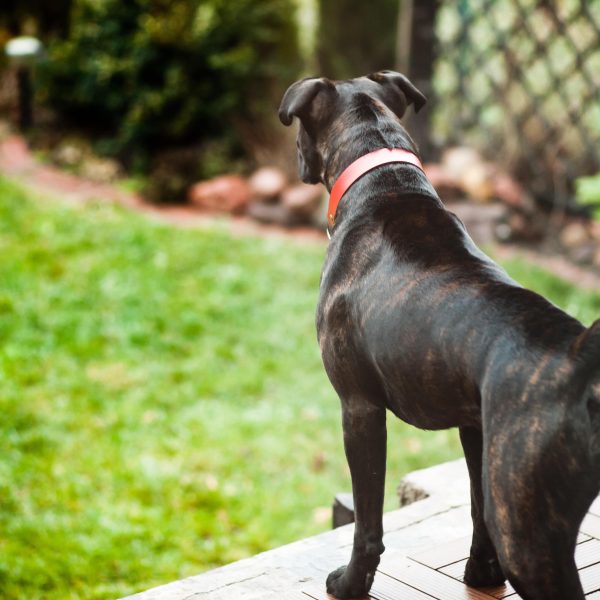How to Calm a Reactive Dog

Owning a reactive dog can be overwhelming sometimes. Their behavior can make simple activities hard, like going on walks or interacting with other dogs and humans. It can even be hard to have guests over in fear of how your dog will react. Rather than just accepting your dog’s behavior as unchangeable, there are a few things to try in order to calm them down. Here’s how to calm a reactive dog:
1. Develop a Solid Routine
Dogs rely on a solid, consistent routine to feel secure and loved. An anxious dog can sometimes be a reactive dog. Creating a solid routine makes the world feel predictable to your dog and they thrive on that.
The more anxious and reactive your dog is, the more they need a solid and reliable routine. Start by consistently feeding your dog at the same time each day, going for walks that follow the same route and same time of day, and having consistent bathroom breaks. This reliable pattern will help your dog feel safe and secure, hopefully relieving some of their anxiety.
2. Invest in Helpful Equipment
While many people have a negative view of muzzles or gentle leaders, these products can help you in managing your reactive dog.
Gentle Leaders
Gentle leaders work well for dogs that are hard pullers during walks. Gentle leaders sit high on the back of the head, which means no pressure on your dog’s throat.
Dog Muzzles
Muzzles help control dogs who tend to snap or bite when anxious or threatened. Look for soft or cage muzzles, which allow your dog to still eat and drink. This will help you and your dog stay safe while in public.
Dog Crate
Another essential tool to have is a crate. A crate, as well as crate training, is necessary for security and safety. Crates are also very useful when introducing your dog to a new environment, a new person, or an animal.
With the right training, dogs begin to associate their crate with a den or safe space. This feeling of security and safety is important for reactive dogs. Crates also make transporting your dog easier, especially for a veterinarian visit.
3. Implement Household Charges
If your dog is reactive at home, it might be time to assess your household routine and make necessary changes. Look for triggers that cause reactivity in your pup. For example, do things outside that your dog can see through windows cause a reaction?
When a dog sees someone or another animal outside, they tend to bark. When that person or animal leaves, your dog thinks the barking caused them to leave. If this becomes a reactive behavior, try to keep your dog away from windows. You can use baby gates or even use blinds to block their view.
Another form of reactivity is acting aggressively toward guests. It’s important to have a routine in place for your dog meeting guests, especially new people. Sometimes, it works to have a designated place for your pup to be in when people arrive. This could be a special room or their crate.
Sometimes, it’s helpful for your dog to see the person but still be separated. Using a baby gate can help keep the separation. Once your dog feels safe and is ready to greet guests, keep a close eye on your dog and be ready to intervene if they show signs of nervousness or fear. Reward good behavior with plenty of praise and treats.
4. Work With a Dog Trainer
There are many causes of aggression in dogs, so you need to make sure you’re addressing the right triggers with your solution. If your dog’s behavior is still fairly reactive, it might be time to seek professional help. Dog trainers are educated in dog behavior and typically understand all different types of dogs. A trainer can work with you to develop a specific plan tailored to your dog and their problems and needs.
Trainers can offer exercises to work on with your dog, help you troubleshoot when a new behavior arises, and can offer insight and advice when you feel overwhelmed. It will take time and effort, which is one of the things trainers wish dog owners knew. But the effort is worth the outcome. Stick with it consistently, and you should see changes,
5. Read Their Body Language
The tip to stop reactive behavior before it begins is to understand your dog’s different types of body language. Dogs will give you clues about their feelings through their behavior. Keep in mind that most dog behavior can be contextual.
For example, a wagging tail can mean a few different things. It can be a sign of happiness and contentment, but it also can mean anxiousness. You will need to look for other clues in their behavior to figure out how they are feeling at a specific moment.
If the wagging tail is accompanied by a little body wiggle and a smiling face, your dog is happy and content. But if they are cowering in a corner, they are nervous or scared. If your dog is nervous, they will have a tense body posture, which is a sign your dog is stressed. Content dogs have very loose bodies. Understanding their body language will help you intervene at the proper time.
These are just a few tips for how to calm a reactive dog. Don’t let your dog’s reactive behavior rule your life. Implementing these changes will improve both your dog’s quality of life as well as yours.
